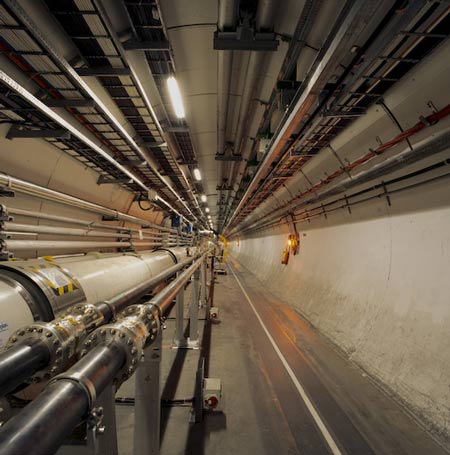Photographer David Cowlard has sent us these construction photos of the world's most powerful particle accelerator, the Large Hadron Collider, which was switched on by the European Organisation for Nuclear Research this week.
The collider was constructed in a 27km tunnel, 100m underground on the border of France and Switzerland, near Geneva.
Cowlard took the photographs in June last year.
"I visited the facility in the final stages of commissioning," he says. "Testing had started on some parts but now the collider is operational most areas are now closed to everyone except the people directly involved in it’s running."
The following information is from David Cowlard:
--
E=MC2
At the beginning of June 2007 photographer David Cowlard visited one of the largest and most important scientific experiments yet conceived. Above: View upwards from the underground CMS cavern showing fire extinguisher nozzles that would fill the cavern with breathable foam within seconds.
The European Organisation for Nuclear Research (CERN) has ‘switched on’ the Large Hadron Collider (LCH). This is the largest particle collider in the world and is set to examine some of the major questions in physics. Currently only 4% of what makes up the Universe is known…the other 96% remains to be examined.
The Collider has been constructed in a 27km tunnel, 100m underground straddling the borders of France and Geneva/Switzerland. The project, a truly global experiment, has involved thousands of scientists and engineers from around the world. Thousands more will be involved in analysing the data which will be produced. Below: Section of the 27km tunnel that straddles the French and Swiss borders near Geneva and shows the dipole magnet and superconducting cable housing.
The LHC will collide protons at almost the speed of light, 40 million times a second, recreating the conditions a fraction of a billionth of a second after the Big Bang. The subsequent collisions will be detected and monitored by four experiments, each contained within caverns at different points around the circumference of the tunnel. They will employ various ways to control the direction of the particles (magnets and solenoids etc) and incorporate a huge amount of sensors. One of the detectors has been described as ‘something like a 700 tonne digital camera’. (Particle Physicist Dr Brian Cox)
To create the conditions of ‘super conductivity’ the specially created ‘cable’ needs to be cooled to a temperature of almost absolute zero or 1.7 degrees Kelvin (-271 degrees C)!! This involves the use of liquid helium in the largest cryogenics plants outside of oil fields. (6000 tonnes of something that weighs nothing). Below: the 100m below-ground entrance to the cavern that houses the CMS experiment.
In addition to the creation of this facility the need to analyse extraordinary amounts of data has meant that there is huge computing power needed. Some of which is on-site but a large proportion of the analysis will be carried out by scientists around the world linked by ‘the grid’ with download speeds of 8Gb/sec.
Below: final assembly of a section of the Compact Muon Solenoid (CMS) Experiment. The CMS detector will comprise of 100 million detecting elements and will look for signs of new particles and phenomena at 40 million times per second. The CMS will be situated 100m underground at the French village of Cessy.

